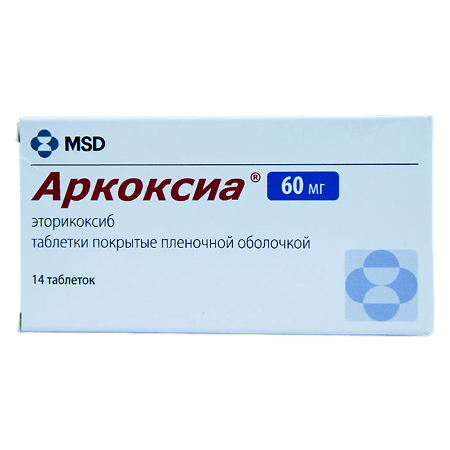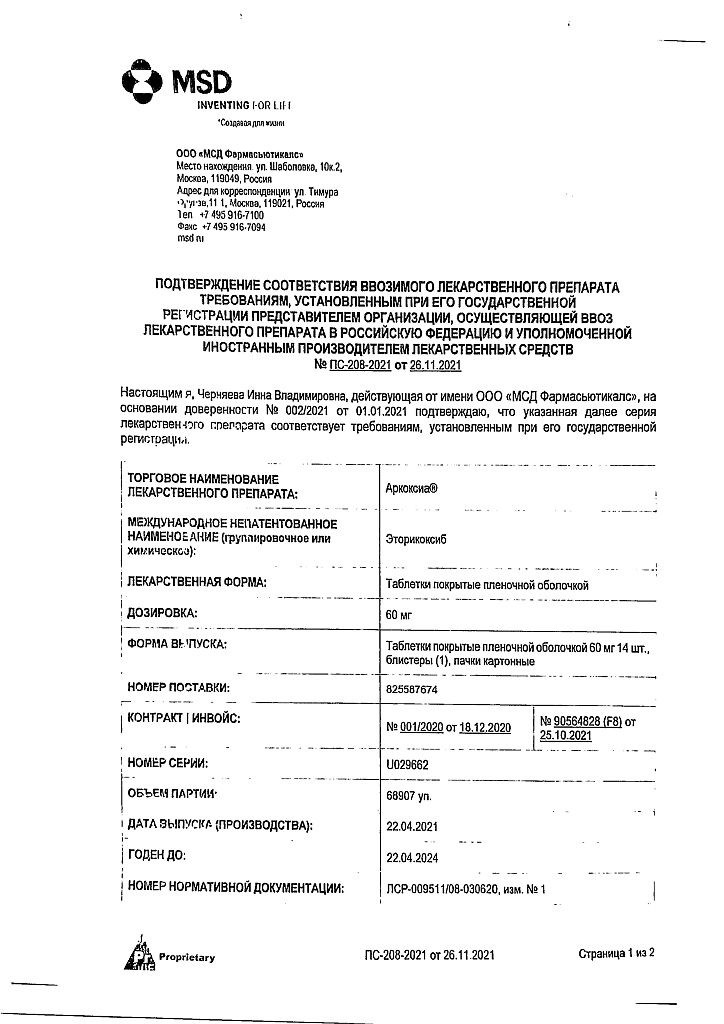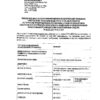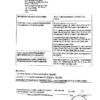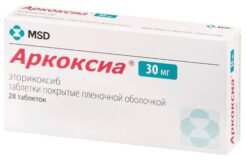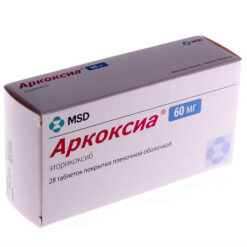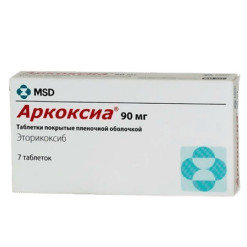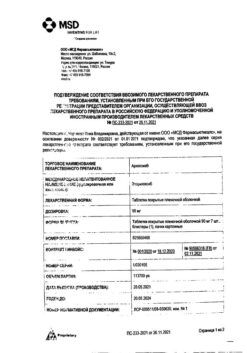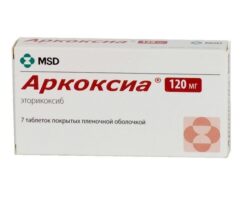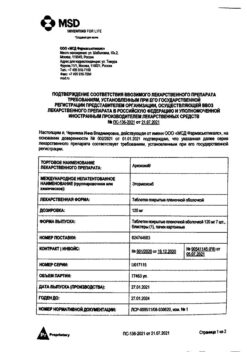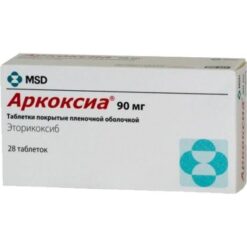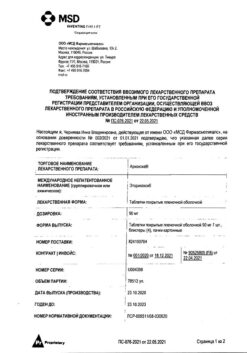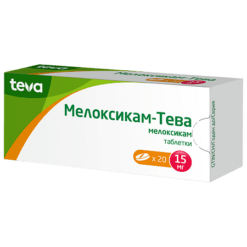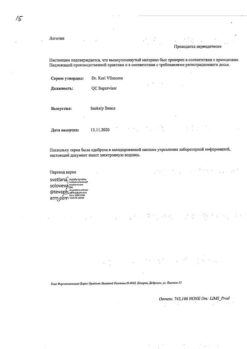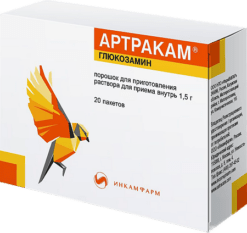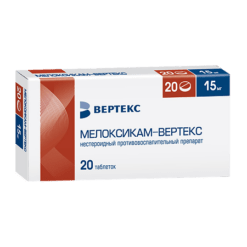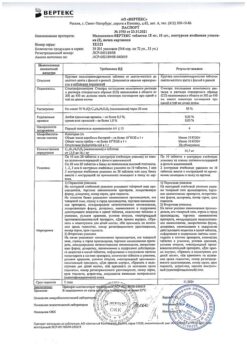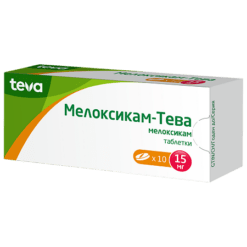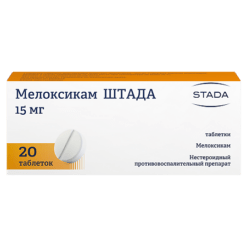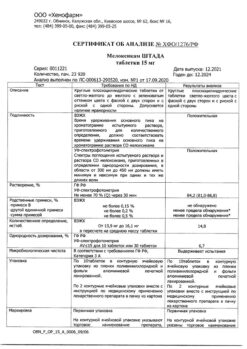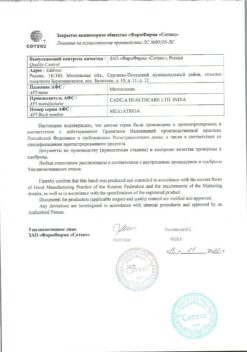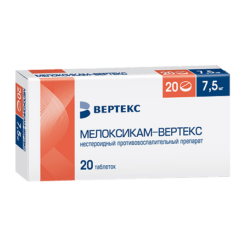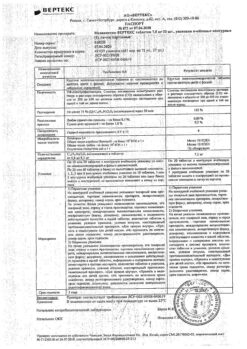No products in the cart.
Arcoxia, 60 mg 14 pcs
€17.98 €14.99
Description
Arcoxia is a nonsteroidal anti-inflammatory drug. It is a selective COX-2 inhibitor, in therapeutic concentrations it blocks formation of prostaglandins and has anti-inflammatory, analgesic and antipyretic effects.
Selective inhibition of COX-2 is accompanied by decrease of severity of clinical symptoms related to the inflammatory process with no effect on platelet function and gastrointestinal mucosa.
Etoricoxib has a dose-dependent effect of COX-2 inhibition with no effect on COX-1 when used in daily doses up to 150 mg.
Arcoxia has no effect on the production of prostaglandins in the gastric mucosa and on bleeding time. In the studies conducted, there was no decrease in arachidonic acid levels and collagen-induced platelet aggregation.
Indications
Indications
Symptomatic treatment of the following diseases and conditions:
Osteoarthritis.
Rheumatoid arthritis.
Ankylosing spondylitis.
Pain and inflammatory symptoms associated with acute gouty arthritis.
Pharmacological effect
Pharmacological effect
Arcoxia is a non-steroidal anti-inflammatory drug. A selective COX-2 inhibitor, in therapeutic concentrations, blocks the formation of prostaglandins and has anti-inflammatory, analgesic and antipyretic effects.
Selective inhibition of COX-2 is accompanied by a decrease in the severity of clinical symptoms associated with the inflammatory process, while there is no effect on platelet function and the gastrointestinal mucosa.
Etoricoxib has a dose-dependent effect of inhibiting COX-2, without affecting COX-1 when used in a daily dose of up to 150 mg.
Arcoxia does not affect the production of prostaglandins in the gastric mucosa and the bleeding time. In the studies conducted, there was no decrease in arachidonic acid levels and platelet aggregation caused by collagen.
Special instructions
Special instructions
Taking the drug Arcoxia® requires careful monitoring of blood pressure. When prescribing the drug, all patients should have their blood pressure monitored during the first two weeks of treatment and periodically thereafter.
Liver and kidney function tests should also be regularly monitored.
If the level of liver transaminases increases by 3 times or more relative to ULN, the drug should be discontinued.
Given the increasing risk of developing undesirable effects with increasing duration of use, it is necessary to periodically evaluate the need to continue taking the drug and the possibility of reducing the dose.
The drug should not be used simultaneously with other NSAIDs.
The shell of Arcoxia® contains lactose in small quantities, which should be taken into account when prescribing the drug to patients with lactase deficiency.
Impact on the ability to drive vehicles and operate machinery
During the treatment period, care must be taken when driving vehicles and engaging in other potentially hazardous activities that require increased concentration and speed of psychomotor reactions. Patients who have experienced episodes of dizziness, drowsiness or weakness should refrain from activities that require concentration.
Active ingredient
Active ingredient
Etoricoxib
Composition
Composition
1 tablet contains:
Active substance:
Etoricoxib 60 mg;
Excipients:
Calcium hydrogen phosphate;
Microcrystalline cellulose;
Croscarmellose sodium;
Magnesium stearate.
Contraindications
Contraindications
Hypersensitivity to any component of the drug;
Complete or incomplete combination of bronchial asthma, recurrent nasal polyposis or paranasal sinuses and intolerance to acetylsalicylic acid and other NSAIDs (including a history);
Erosive and ulcerative changes in the mucous membrane of the stomach or duodenum, active gastrointestinal bleeding; cerebrovascular or other bleeding;
Inflammatory bowel diseases (Crohn’s disease, ulcerative colitis) in the acute phase;
Hemophilia and other bleeding disorders;
Severe heart failure (NYHA II-IV);
Severe liver failure (more than 9 points on the Child-Pugh scale) or active liver disease;
Severe renal failure (creatinine clearance less than 30 ml/min), progressive kidney disease, confirmed hyperkalemia;
The period after coronary artery bypass surgery; peripheral arterial diseases, cerebrovascular diseases, clinically significant coronary heart disease;
Persistent blood pressure values exceeding 140/90 mmHg. Art. with uncontrolled arterial hypertension;
Pregnancy, breastfeeding period;
Children’s age up to 16 years.
Side Effects
Side Effects
From the digestive system: often – epigastric pain, heartburn, nausea, diarrhea, dyspepsia, flatulence; uncommon – bloating, belching, increased peristalsis, constipation, dry oral mucosa, gastritis, ulcer of the gastric or duodenal mucosa, irritable bowel syndrome, esophagitis, ulcers of the oral mucosa, vomiting; very rarely – gastrointestinal ulcers (with bleeding or perforation), hepatitis.
From the nervous system: often – headache, dizziness, weakness; uncommon – taste disturbance, drowsiness, sleep disturbances, sensory disturbances, incl. paresthesia/hyperesthesia, anxiety, depression, concentration disorders; very rarely – hallucinations, confusion.
From the senses: infrequently – blurred vision, conjunctivitis, tinnitus, vertigo.
From the urinary system: infrequently – proteinuria; very rarely – renal failure, usually reversible when the drug is discontinued.
Allergic reactions: very rarely – anaphylactic/anaphylactoid reactions, including a pronounced decrease in blood pressure and shock.
From the cardiovascular system: often – palpitations, increased blood pressure; uncommon – hot flashes, cerebrovascular accident, atrial fibrillation, congestive heart failure, nonspecific ECG changes; myocardial infarction; very rarely – hypertensive crisis.
From the respiratory system: infrequently – cough, shortness of breath, nosebleeds; very rarely – bronchospasm.
Dermatological reactions: often – ecchymosis; infrequently – swelling of the face, itching, rash; very rarely – urticaria, Stevens-Johnson syndrome, Lyell’s syndrome.
Infectious complications: uncommon – gastroenteritis, infections of the upper respiratory tract, urinary tract.
From the musculoskeletal system: infrequently – muscle cramps, arthralgia, myalgia.
Metabolism: often – swelling, fluid retention; infrequently – changes in appetite, weight gain.
From laboratory tests: often – increased activity of liver transaminases; uncommon – increased nitrogen in the blood and urine, increased CPK activity, decreased hematocrit, decreased hemoglobin, hyperkalemia, leukopenia, thrombocytopenia, increased serum creatinine, increased uric acid; rarely – increased sodium in the blood serum.
Other: often – flu-like syndrome; infrequently – chest pain.
Interaction
Interaction
Pharmacodynamic interaction
In patients receiving warfarin, taking Arcoxia® at a dose of 120 mg/day was accompanied by an increase of approximately 13% in MHO and prothrombin time. In patients receiving warfarin or similar drugs, MHO levels should be monitored when initiating therapy or changing the Arcoxia® dosage regimen, especially in the first few days.
There are reports that non-selective NSAIDs and selective COX-2 inhibitors may weaken the hypotensive effect of ACE inhibitors. This interaction should be taken into account when treating patients taking Arcoxia® concomitantly with ACE inhibitors. In patients with impaired renal function (for example, with dehydration or in old age), such a combination may aggravate renal failure.
Arcoxia® can be used simultaneously with acetylsalicylic acid in low doses intended for the prevention of cardiovascular diseases. However, simultaneous administration of acetylsalicylic acid in low doses and Arcoxia® may lead to an increase in the incidence of gastrointestinal ulcers and other complications compared to taking Arcoxia® alone. After reaching a steady state, taking etoricoxib at a dose of 120 mg 1 time / day does not affect the antiplatelet activity of acetylsalicylic acid in low doses (81 mg / day). The drug does not replace the preventive effect of acetylsalicylic acid in cardiovascular diseases.
Cyclosporine and tacrolimus increase the risk of nephrotoxicity while taking Arcoxia®.
Pharmacokinetic interaction
There is evidence that non-selective NSAIDs and selective COX-2 inhibitors may increase plasma lithium concentrations. This interaction should be taken into account when treating patients taking Arcoxia® concomitantly with lithium.
Two studies examined the effects of Arcoxia® at doses of 60, 90 and 120 mg once a day for seven days in patients receiving methotrexate at a dose of 7.5 to 20 mg once a week for rheumatoid arthritis. Arcoxia® at a dose of 60 and 90 mg had no effect on the plasma concentration (according to AUC) and renal clearance of methotrexate. In one study, Arcoxia® at a dose of 120 mg had no effect on the plasma concentration (AUC) and renal clearance of methotrexate. In another study, Arcoxia® at a dose of 120 mg increased the plasma concentration of methotrexate by 28% (based on AUC) and decreased the renal clearance of methotrexate by 13%. When prescribing Arcoxia® at doses above 90 mg/day and methotrexate simultaneously, monitoring for the possible occurrence of toxic effects of methotrexate should be carried out.
Oral contraceptives: Taking Arcoxia® at a dose of 120 mg with oral contraceptives containing 35 mcg ethinyl estradiol and 0.5 to 1 mg norethindrone for 21 days, simultaneously or 12 hours apart, increases the steady-state AUC0-24 of ethinyl estradiol by 50-60%. However, norethisterone concentrations usually do not increase to a clinically significant extent. This increase in ethinyl estradiol concentrations should be taken into account when selecting the appropriate oral contraceptive for concomitant use with Arcoxia®. This fact may lead to an increased incidence of thromboembolism due to increased exposure to ethinyl estradiol. No significant pharmacokinetic interaction with GCS was detected.
Etoricoxib does not affect AUC0-24 at steady state or digoxin elimination. However, etoricoxib increases Cmax (by an average of 33%), which may be important in the development of digoxin overdose.
Co-administration of Arcoxia® and rifampicin (a powerful inducer of hepatic metabolism) leads to a 65% decrease in plasma etoricoxib AUC. This interaction should be taken into account when Arcoxia® is co-administered with rifampicin.
Antacids and ketoconazole (a strong CYP3A4 inhibitor) do not have a clinically significant effect on the pharmacokinetics of Arcoxia®.
Overdose
Overdose
Overdose of Arcoxia® was not reported in clinical trials. In clinical trials, a single dose of Arcoxia® in a single dose of up to 500 mg or repeated doses of up to 150 mg/day for 21 days did not cause significant toxic effects.
Symptoms: in case of an overdose of the drug, undesirable effects from the gastrointestinal tract, cardiovascular system and kidneys may occur.
Treatment: carry out symptomatic therapy. Etoricoxib is not eliminated by hemodialysis; elimination of the drug by peritoneal dialysis has not been studied.
Storage conditions
Storage conditions
In a dry place, protected from light, at a temperature not exceeding 30 ºС.
Shelf life
Shelf life
3 years.
Manufacturer
Manufacturer
Rovi Pharma Industrial Services S.A., Spain
Additional information
| Shelf life | 3 years. |
|---|---|
| Conditions of storage | In a dry, light-protected place at a temperature not exceeding 30 ºC. |
| Manufacturer | Rovi Pharma Industrial Services S.A., Spain |
| Medication form | pills |
| Brand | Rovi Pharma Industrial Services S.A. |
Other forms…
Related products
Buy Arcoxia, 60 mg 14 pcs with delivery to USA, UK, Europe and over 120 other countries.

